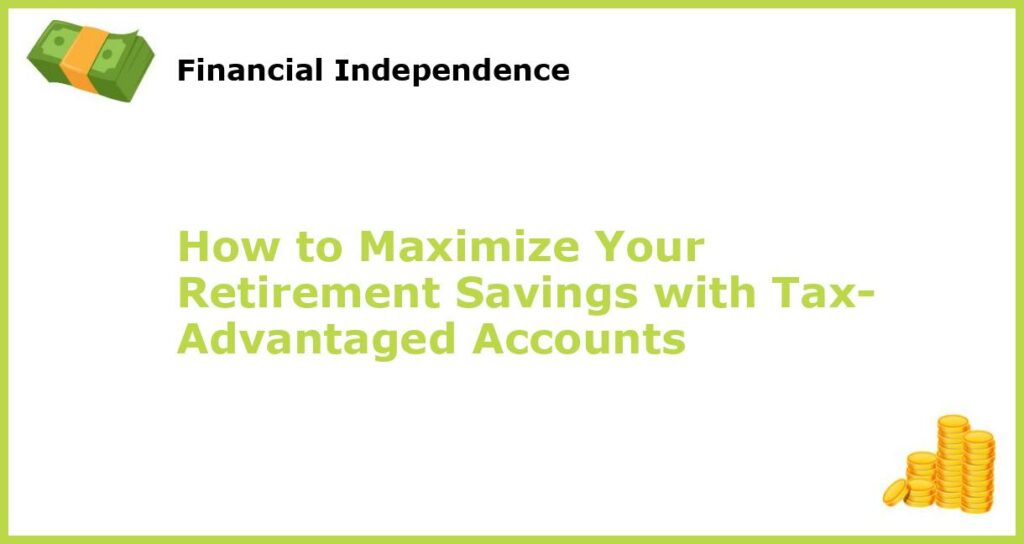Let’s face it, retirement can be a daunting prospect, especially if you’re not sure how you’ll be able to live the life you want without a steady income. Fortunately, there are ways to prepare for retirement that can ease your worries and help you maximize your savings. One of the best ways to do this is by using tax-advantaged retirement accounts. These accounts offer a range of tax benefits that can help you save more money for retirement than traditional savings accounts or investments.
Why Should You Use Tax-Advantaged Accounts?

Tax-advantaged retirement accounts offer a range of benefits that can help you save more money for retirement than traditional accounts or investments. First, they offer tax breaks that can make a big difference in your bottom line. For example, with a Traditional IRA, you can deduct your contributions from your income taxes, which means you’ll pay less in taxes now. With a Roth IRA, you won’t get an upfront tax break, but you won’t have to pay taxes on your withdrawals in retirement.
Another benefit of tax-advantaged accounts is that they allow your savings to grow tax-free over time. This means that you won’t have to pay taxes on any investment gains until you withdraw the money in retirement.
What Are Tax-Advantaged Accounts?

Tax-advantaged accounts are investment accounts that are designed to help you save for retirement while taking advantage of tax breaks. Some of the most popular tax-advantaged accounts include Traditional and Roth IRAs, 401(k)s, and HSAs.
Traditional and Roth IRAs are popular because they offer tax benefits and are relatively easy to set up. A Traditional IRA allows you to deduct your contributions from your income taxes, but you’ll have to pay taxes on your withdrawals in retirement. A Roth IRA offers no upfront tax deduction, but you won’t have to pay taxes on your withdrawals in retirement.
401(k)s and other employer-sponsored retirement accounts are also popular because they often offer matching contributions from your employer. This is essentially free money that you can put towards your retirement savings.
Traditional IRA vs. Roth IRA: Which One Is Right for You?

If you’re considering opening an IRA, one of the first decisions you’ll need to make is whether to open a Traditional or Roth IRA. Both types of IRAs offer tax benefits, but the timing of those benefits is different.
With a Traditional IRA, you can deduct your contributions from your income taxes now, which means you’ll pay less in taxes now. However, you’ll have to pay taxes on your withdrawals in retirement. With a Roth IRA, you won’t get an upfront tax deduction, but you won’t have to pay taxes on your withdrawals in retirement.
The choice between a Traditional and Roth IRA will depend on your personal financial situation and your goals for retirement. If you expect to be in a lower tax bracket in retirement than you are now, a Traditional IRA may be a better choice. If you expect to be in a higher tax bracket in retirement, a Roth IRA may be a better choice.
401(k)s and Other Employer-Sponsored Retirement Accounts

If you’re lucky enough to have access to an employer-sponsored retirement account, such as a 401(k), you should take full advantage of it if you can. These plans often offer matching contributions from your employer, which is essentially free money that you can put towards your retirement savings.
When you contribute to a 401(k), your contributions are deducted from your paycheck before taxes are taken out. This means that you’ll pay less in taxes now. The money in your 401(k) will grow tax-free until you withdraw it in retirement, at which point you’ll pay taxes on your withdrawals.
One thing to keep in mind with 401(k)s is that there are limits to how much you can contribute each year. In 2021, the maximum you can contribute to a 401(k) is $19,500. If you’re over 50, you can also make catch-up contributions of up to $6,500.
How Much Should You Contribute?

When it comes to contributing to your tax-advantaged retirement accounts, the answer is simple: as much as you can afford to. The more money you can save now, the more money you’ll have available in retirement to live the life you want.
Most retirement experts recommend that you contribute at least 10–15% of your income to your retirement savings. If you’re able to contribute more than that, even better.
Investing Your Retirement Savings

Once you’ve opened your tax-advantaged retirement accounts and started contributing to them, the next step is to invest your savings. This means putting your money into a mix of stocks, bonds, and other investments that can help your retirement savings grow over time.
The investment strategy you choose will depend on your risk tolerance, your time horizon, and your retirement goals. One common strategy is to invest in a mix of stocks and bonds that is appropriate for your age and risk tolerance. This can help you achieve the right balance of risk and reward as you save for retirement.
Monitoring Your Retirement Accounts
Another important step in maximizing your retirement savings is to regularly monitor your accounts and make any necessary adjustments as your goals change over time. This might mean changing your investment mix or increasing your contributions if you come into more money.
To make sure you’re on track for a comfortable retirement, it’s a good idea to review your retirement accounts at least once per year. This will help you ensure that you’re saving enough and investing your savings appropriately.
Other Tax-Advantaged Retirement Accounts to Consider
In addition to the accounts we’ve already mentioned, there are several other tax-advantaged retirement accounts that you may want to consider. These include SEP-IRAs, SIMPLE IRAs, and 457 plans.
A SEP-IRA is a retirement plan that is specifically designed for self-employed individuals and small business owners. With a SEP-IRA, you can make tax-deductible contributions to your retirement savings.
A SIMPLE IRA is a retirement plan that is also designed for small business owners. With a SIMPLE IRA, you can make tax-deductible contributions to your retirement savings, and your employer can also contribute to your account.
A 457 plan is a retirement plan that is available to certain types of government employees. With a 457 plan, you can make tax-deductible contributions to your retirement savings, and the money in your account will grow tax-free until you withdraw it in retirement.
The Bottom Line
Maximizing your retirement savings with tax-advantaged accounts takes some effort, but the rewards are well worth it. With a little planning and discipline, you can build a retirement nest egg that will allow you to live the life you want in retirement.







